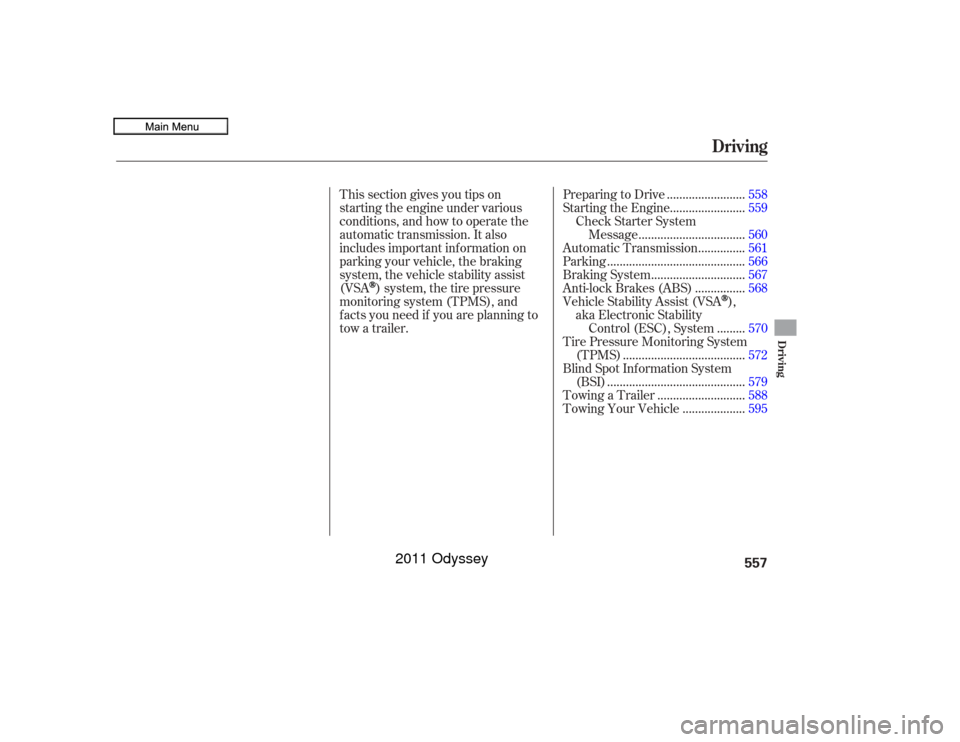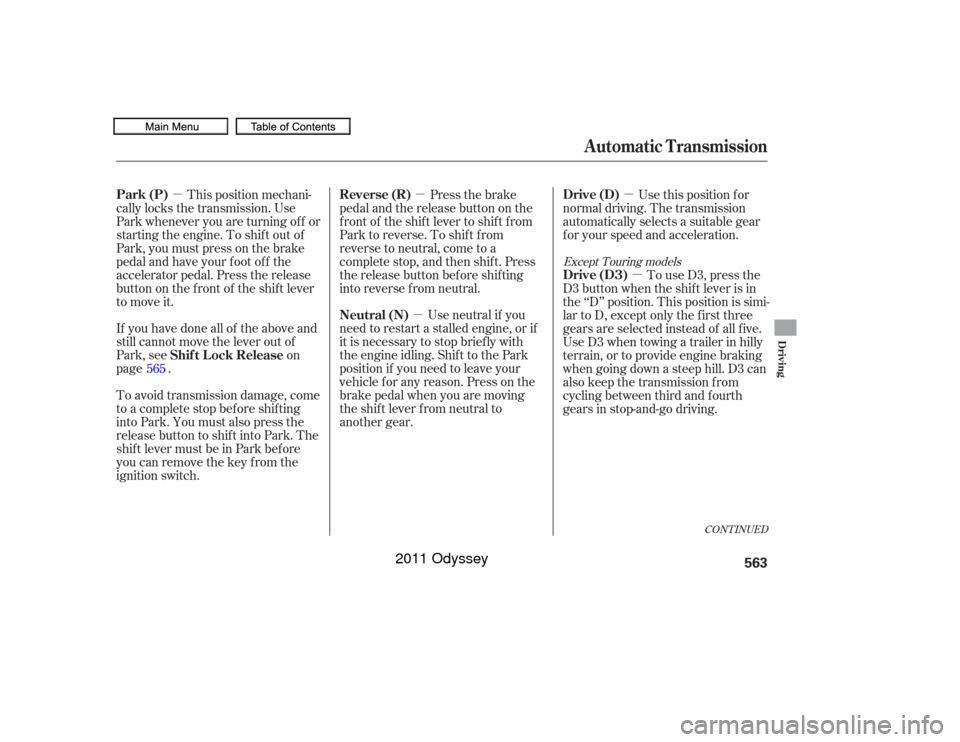Page 548 of 722
Refer toon page f or inf ormation
about checking other items on your
vehicle. Look at the coolant level in the
radiator reserve tank. Make sure it is
between the MAX and MIN lines. If
it is below the MIN line, see on page f or
inf ormation on adding the proper
coolant.
Remove the dipstick again, and
check the level. It should be
between the upper and lower
marks.
If it is near or below the lower mark,
see on page .
Park the vehicle on a level surf ace.
Wait a f ew minutes af ter turning the
engine of f bef ore you check the oil.
Remove the dipstick (orange loop).
Wipe of f the dipstick with a clean
cloth or paper towel.
Insert the dipstick all the way back
into its hole. 4.
618
614
1.
2.
3.
611Service Station Procedures
Owner’s Maintenance
Checks A dding
Engine Coolant Engine Coolant Check
A dding Engine Oil
Oil Check
Bef ore Driving
545
UPPER MARK
LOWER MARK
MIN
MAX RESERVE TANK
DIPSTICK
10/07/17 10:47:47 31TK8600_550
2011 Odyssey
Page 550 of 722

�µ�µ�µ �µ
�µ �µ
�µ
Aggressive driving (hard
acceleration and braking)
Excessive idling, accelerating and
braking in stop-and-go traf f ic
Cold engine operation (engines
aremoreefficientwhenwarmed
up)
Driving with a heavy load or the
air conditioner running
Improperly inf lated tires
An underinf lated tire increases
‘‘rolling resistance,’’ which reduces
f uel economy.
It puts a heavier
load on the engine, increasing f uel
consumption.
In
particular, a build-up of snow or
mud on your vehicle’s underside
adds weight and rolling resistance.
Frequent cleaning helps your f uel
economy.
The f ollowing f actors can lower your
vehicle’s f uel economy:
A properly maintained vehicle
maximizes f uel economy. Poor
maintenance can signif icantly reduce
fuel economy. Always maintain your
vehicle according to the maintenance
messages displayed on the multi-
inf ormation display (see
on page ).
For example: Idling
results in 0 miles per gallon (0 kms
per liter). If your vehicle has a
manual transmission, you can
boost your f uel economy by up
shif ting as early as possible. Aerodynamic drag has a big ef f ect
on f uel economy at speeds above
45 mph (75 km/h). Reduce your
speed and you reduce the drag.
Trailers, car top carriers, roof
racks and bike racks are also big
contributors to increased drag.
Rapid
acceleration, abrupt cornering,
and hard braking increase fuel
consumption.
611
CONT INUED
Fuel Economy Factors Use the recommended viscosity
motor oil, displaying the A PI
Certif ication Seal (see page ).
Maintain proper tire inf lation
A void carrying excess weight in
your vehicle
K eep your vehicle clean
Improving Fuel Economy
Owner’s
Maintenance Checks Avoid excessive idling A lways drive in the highest gear
possible Observe the speed limit
Drive moderately 614
Drive Ef f icient ly
Vehicle Maint enance
Fuel Economy
Bef ore Driving
547
10/07/17 10:48:09 31TK8600_552
2011 Odyssey
Page 551 of 722
�µ�µ
Fill the f uel tank until the nozzle automatically clicks of f .
Reset trip counter to zero.
Record the total gallons (liters) needed to ref ill.
Follow one of the simple calculations above.
Direct calculation is the
recommended source of inf ormation
about your actual f uel economy.
Using f requency of f ill-ups or taking
f uel gauge readings are NOT
accurate measures of f uel economy.
Fuel economy may improve over the
f irst several thousand miles
(kilometers). The A/C
puts an extra load on the engine
which makes it use more f uel. Use
the f resh-air ventilation when
possible.
Combine several short trips into
one. A warmed-up engine is more
f uel ef f icient than a cold one.
1)
2)
3)
4)
Checking Your Fuel Economy
Measuring T echniques
Calculating Fuel Economy Minimize the use of the air
conditioning system
Plan and combine tripsFuel Economy548
Miles
driven Gallons
of fuel Miles per
Gallon
100 KilometersLper
100 km
Liter
10/07/17 10:48:18 31TK8600_553
2011 Odyssey
Page 560 of 722

This section gives you tips on
starting the engine under various
conditions, and how to operate the
automatic transmission. It also
includes important inf ormation on
parking your vehicle, the braking
system, the vehicle stability assist
(VSA
) system, the tire pressure
monitoring system (TPMS), and
f acts you need if you are planning to
tow a trailer. ........................
Preparing to Drive .558
.......................
Starting the Engine .559
Check Starter System .................................
Message .560
..............
Automatic Transmission . 561
...........................................
Parking .566
.............................
Braking System .567
...............
Anti-lock Brakes (ABS) . 568
Vehicle Stability Assist (VSA
),
aka Electronic Stability ........
Control (ESC), System . 570
Tire Pressure Monitoring System ......................................
(TPMS) .572
Blind Spot Inf ormation System ...........................................
(BSI) .579
...........................
Towing a Trailer .588
...................
Towing Your Vehicle . 595
Driving
Driving
557
10/07/17 10:49:29 31TK8600_562
2011 Odyssey
Page 561 of 722

Youshoulddothefollowingchecks
and adjustments bef ore you drive
your vehicle.Make sure all windows, mirrors,
and outside lights are clean and
unobstructed. Remove f rost, snow,
or ice.
Check that the hood is f ully closed.
Check that any items you may be
carrying are stored properly or
f astened down securely. Check the steering wheel
adjustment (see page ).
Make sure the doors and the
tailgate are securely closed and
locked.Fasten your seat belt. Check that
your passengers have f astened
their seat belts (see page ).
When you start the engine, check
the gauges and indicators in the
instrument panel, and the
messages on the inf ormation
display or multi-inf ormation
display (depending on models)
(seepages,,,and
).
Visually check the tires. If a tire
looks low, use a gauge to check its
pressure. Check the seat adjustment (see
pages and ).
Check the adjustment of the
inside and outside mirrors (see
pages and ).
3. 2.
1.
4. 5.
6.
7.
8. 9.
10. 15
176
175
198
197
63 64 77
90
143Preparing to Drive558
10/07/17 10:49:39 31TK8600_563
2011 Odyssey
Page 562 of 722

�µ
Apply the parking brake.
In cold weather, turn of f all
electrical accessories to reduce
the drain on the battery.
Make sure the shif t lever is in
Park. Press on the brake pedal.
Your vehicle’s starter system has an
auto control mode. When you turn
the ignition switch to the START
(III) position, this f eature keeps the
engine’s starter motor running until
the engine starts. Follow these
instructions to start the engine:
Without touching the accelerator
pedal, turn the ignition switch to
the START (III) position, then
release the ignition switch. You do
not need to hold the ignition
switch in the START (III) position
to start the engine. The starter
motor runs until the engine starts
or a maximum of 10 25 seconds
depending on engine coolant
temperature.
If the engine does not start, wait at
least 10 seconds bef ore trying
again.
1.
2.
3. 4.
Starting the Engine
Driving
559
Immobilizer System
The engine is harder to start in cold
weather. Also, the thinner air f ound at
altitudes above 8,000 f eet (2,400
meters) adds to this problem. T he immobilizer system protects your
vehicle f rom thef t. If an improperly
coded key (or other device) is used, the
engine’s f uel system is disabled. See
on page .145
10/07/17 10:49:46 31TK8600_564
2011 Odyssey
Page 563 of 722
If this message is on, the ignition
switchhastobeheldintheSTART
(III) position manually until the
engine starts. The ignition switch
canbeheldinthatpositionupto15
seconds.
Even though you may be able to
start the engine manually without
the auto control mode of the starting
system, have your vehicle inspected
by a dealer.
If there is a problem with the starter
system, you will see a ‘‘CHECK
STARTER SYSTEM’’ message on
the multi-information display when
the ignition switch is turned to the
ON (II) position. You will also see
this message when the auto control
mode of the starter system has a
problem.
On Touring modelsStarting the EngineCheck Starter System Message560
10/07/17 10:49:51 31TK8600_565
2011 Odyssey
Page 566 of 722

�µ�µ
�µ�µ
�µ
CONT INUED
If you have done all of the above and
still cannot move the lever out of
Park, seeon
page .
To avoid transmission damage, come
to a complete stop bef ore shif ting
into Park. You must also press the
release button to shift into Park. The
shif t lever must be in Park bef ore
you can remove the key f rom the
ignition switch. Use neutral if you
need to restart a stalled engine, or if
it is necessary to stop brief ly with
the engine idling. Shif t to the Park
position if you need to leave your
vehicle for any reason. Press on the
brake pedal when you are moving
the shift lever from neutral to
another gear. Use this position f or
normal driving. The transmission
automatically selects a suitable gear
f or your speed and acceleration.
This position mechani-
cally locks the transmission. Use
Park whenever you are turning of f or
starting the engine. To shif t out of
Park, you must press on the brake
pedal and have your f oot of f the
accelerator pedal. Press the release
buttononthefrontof theshiftlever
to move it. Press the brake
pedal and the release button on the
frontoftheshiftlevertoshiftfrom
Park to reverse. To shif t f rom
reverse to neutral, come to a
completestop,andthenshift.Press
the release button bef ore shif ting
into reverse f rom neutral. To use D3, press the
D3buttonwhentheshiftleverisin
the ‘‘D’’ position. This position is simi-
lartoD,exceptonlythefirstthree
gears are selected instead of all f ive.
Use D3 when towing a trailer in hilly
terrain, or to provide engine braking
when going down a steep hill. D3 can
also keep the transmission f rom
cycling between third and f ourth
gears in stop-and-go driving.
565
Except Touring models
Automatic Transmission
Shif t L ock Release Neutral (N) Drive (D)
Park (P) Reverse (R)
Drive (D3)
Driving
563
10/07/17 10:50:12 31TK8600_568
2011 Odyssey